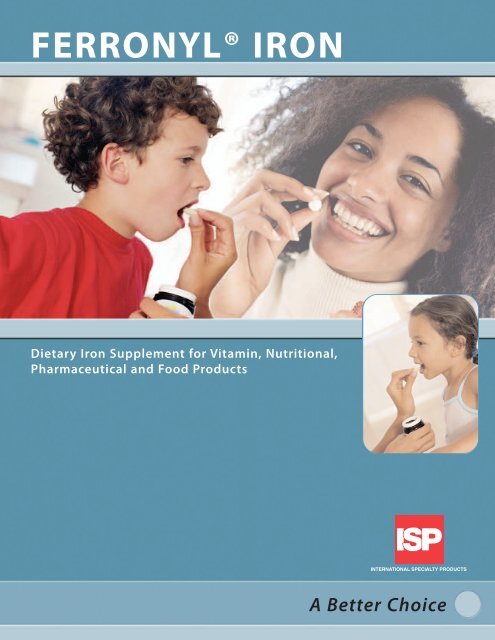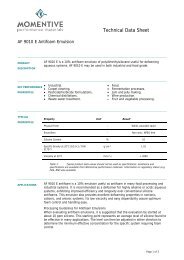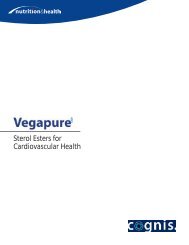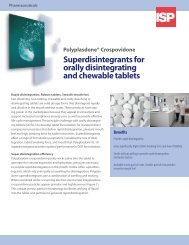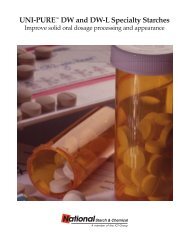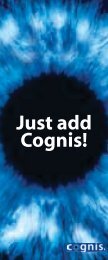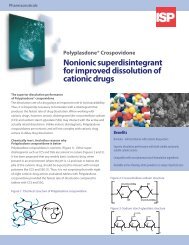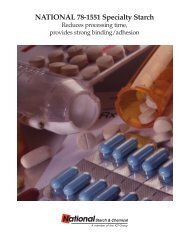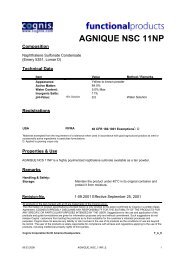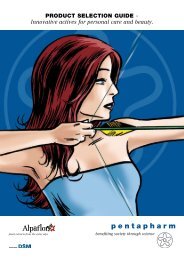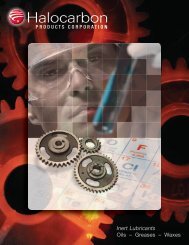You also want an ePaper? Increase the reach of your titles
YUMPU automatically turns print PDFs into web optimized ePapers that Google loves.
<strong>FERRONYL®</strong> <strong>IRON</strong><br />
Dietary Iron Supplement for Vitamin, Nutritional,<br />
Pharmaceutical and Food Products<br />
INTERNATIONAL SPECIALTY PRODUCTS<br />
A Better Choice
Contents<br />
Introduction 3<br />
Physical and Chemical Properties 4-6<br />
Product Description<br />
Iron Content<br />
Particle Morphology<br />
Particle Size and Particle Size Distribution<br />
Stability<br />
Bioavailability 7<br />
Applications 8-9<br />
Tablets<br />
Liquid Suspensions<br />
Safety and Toxicity Summary 10-13<br />
Poison Control Statistics<br />
Animal Toxicity Studies<br />
Regulatory 14<br />
Summary 15<br />
References 15
Introduction<br />
Iron deficiency continues to be a concern around the<br />
world, especially in women and children, often resulting<br />
in anemia. One approach to prevent iron deficiency is<br />
supplementation of food, vitamins and nutritional<br />
products. In formulating an iron supplement, one must<br />
consider bioavailability, toxicity, side effects, iron content,<br />
stability, taste and ease of formulation when selecting an<br />
iron source. Ferronyl® iron is an ideal source of essentially<br />
pure iron with low toxicity, minimal metallic taste and<br />
excellent bioavailability. Thus, it is the better choice for<br />
iron supplementation.<br />
Ferronyl iron powder is elemental iron (Fe) with high (><br />
98%) iron content. High iron content results in lower use<br />
levels to achieve same daily intake levels compared to<br />
ferrous (Fe 2+ ) salts (e.g., ferrous sulfate, ferrous fumarate,<br />
or ferrous gluconate). This is important in multivitamin<br />
formulations where smaller tablets are preferred for<br />
consumer compliance, but often difficult to achieve with<br />
the large number of actives in a formulation.<br />
Benefits of Ferronyl Iron Powder<br />
●<br />
Low Use Levels<br />
In addition to the high iron content, a key physical<br />
property of Ferronyl iron is its fine spherical particle size<br />
that results in higher human bioavailability than other<br />
elemental iron forms.<br />
Each year accidental iron overdose accounts for a<br />
significant number of emergency room visits and too<br />
many childhood deaths. Thus, one must consider toxicity<br />
when selecting an iron source for a supplement product.<br />
Ferronyl iron is far less toxic than soluble iron salts, it<br />
causes fewer side effects, and the slow absorption from<br />
the GI tract provides time for clinical intervention in the<br />
event of accidental overdose.<br />
●<br />
●<br />
●<br />
●<br />
●<br />
Low Toxicity<br />
Excellent Bioavailability<br />
Highly Resistant to Oxidation<br />
Easy to Formulate<br />
Generally Recognized as Safe (GRAS)<br />
With its low use level, excellent bioavailability and low<br />
toxicity, Ferronyl iron is a better choice for iron<br />
supplementation, of:<br />
●<br />
●<br />
●<br />
Multivitamin and iron supplement tablets;<br />
Chewable vitamin tablets; and<br />
Liquid suspensions.<br />
A Better Choice 3
Physical & Chemical Properties<br />
Product Description<br />
Ferronyl iron powder is elemental iron manufactured by the chemical decomposition of iron<br />
pentacarbonyl. The resulting iron particles are small, uniform particles of high purity with only traces of<br />
carbon, oxygen and nitrogen.<br />
Chemical Description:<br />
Elemental Iron<br />
CAS Registry Number: 7439-89-6<br />
CAS Registry Name:<br />
Iron<br />
Chemical Formula:<br />
Fe<br />
Synonyms:<br />
Carbonyl iron, carbonyl iron powder (CIP)<br />
Iron Content<br />
With greater than 98% iron, Ferronyl iron has a much higher iron level than ferrous salts, such as ferrous<br />
gluconate, ferrous sulfate and ferrous fumarate (Table 1). As a result, substantially less Ferronyl iron is<br />
required to reach the same unit dose than a ferrous salt, resulting in lower tablet weight. This makes<br />
Ferronyl iron well suited for multivitamin applications with high active levels as Ferronyl iron can reduce<br />
tablet weight.<br />
Table 1. Less Ferronyl iron is required to reach same unit dose compared to other iron sources.<br />
Ferronyl Iron<br />
(Fe)<br />
Ferrous Gluconate<br />
(C 12 H 22 O 19 Fe)<br />
Ferrous Fumarate<br />
(C 4 H 2 FeO 4 )<br />
Ferrous Sulfate<br />
(FeSO 4 )<br />
% Iron 98 12 32 36<br />
Molecular Weight 56 446 170 152<br />
Amount of Iron<br />
Supplement needed to<br />
meet US RDA*<br />
18.4 mg 150.0 mg 54.4 mg 50.0 mg<br />
*RDA (Recommended Daily Allowance) for Adults is 18 mg/day.<br />
4
Physical & Chemical Properties<br />
Particle Morphology<br />
Ferronyl carbonyl iron powder (CIP) is a grey powder. When<br />
examined under a scanning electron microscope (SEM),<br />
Ferronyl iron particles are highly spherical (Figure 1). The<br />
spherical particle morphology provides for excellent flow<br />
during manufacturing.<br />
Figure 1. Ferronyl iron particles are<br />
spherical providing good flow properties.<br />
Particle Size and Particle Size Distribution<br />
Ferronyl carbonyl iron has a narrow particle size distribution (Figure 2). The typical average particle size is<br />
about 7 to 9 microns which is smaller than the 10-100 microns of other forms of elemental iron (e.g.,<br />
reduced, electrolytic and atomized). This small particle size contributes to its high bioavailability.<br />
With a narrow particle size distribution, Ferronyl iron does not require additional processing prior to<br />
formulation. Other iron sources can have wide particle size distributions and, thus, must be sieved, milled<br />
or ground prior to use which adds time and cost to the manufacturing process.<br />
Figure 2. Ferronyl carbonyl iron has a narrow particle size distribution and<br />
small particle size.<br />
Typical Average Particle Size = 7-9 µm<br />
10<br />
Volume %<br />
0.1 1.0 10.0 100.0 1000.0<br />
Particle Diameter (µm)<br />
0<br />
A Better Choice 5
Physical & Chemical Properties<br />
Stability<br />
Ferronyl iron is stable without loss of efficacy, even under elevated temperature and humidity.<br />
When Ferronyl iron was formulated with Vitamin C (50:50 blend) and held in a humidity chamber for<br />
several weeks, only slight color changes were noted. This is the result of the Ferronyl carbonyl iron being<br />
relatively impervious to atmospheric oxidation. In contrast to other iron sources, such as ferrous salts,<br />
Ferronyl iron shows significantly less color change at elevated temperature and humidity (Table 2).<br />
Table 2. Ferronyl iron, in combination with Vitamin C, shows minimal color change under elevated temperature<br />
and humidity.<br />
Iron<br />
Source<br />
Ambient<br />
Elevated Temperature<br />
(45 o C)<br />
Elevated Temperature and<br />
Relative Humidity<br />
(45 o C and 75% RH)<br />
Week 1 Week 2 Week 3 Week 1 Week 2 Week 3 Week 1 Week 2 Week 3<br />
Ferronyl<br />
Iron<br />
OK OK OK OK OK OK OK<br />
Very<br />
slightly<br />
off color<br />
Slightly<br />
off color<br />
Ferrous<br />
Fumarate<br />
OK OK OK OK OK OK<br />
Slightly<br />
off color<br />
Dark<br />
Very<br />
Dark<br />
Brown<br />
Ferrous<br />
Sulfate<br />
OK OK OK OK<br />
Slightly<br />
off color<br />
Off color<br />
OK<br />
Slightly<br />
off color<br />
Off<br />
color<br />
Ferrous<br />
Gluconate<br />
OK<br />
Slightly<br />
off color<br />
Off color<br />
OK<br />
Slightly<br />
off color<br />
Off color<br />
OK<br />
Slightly<br />
off color<br />
Black<br />
6
Bioavailability<br />
The amount of iron absorbed by the body per unit dosage from a particular iron source is a function of<br />
several factors - particle size, surface area, ionic charge, iron content. The first three of these factors<br />
contribute to the relative biological value (RBV) of the iron source - a measure of how quickly the iron<br />
enters the blood stream. The iron content is a function of molecular structure, i.e., elemental iron versus<br />
ferrous salts like ferrous sulfate (FeSO 4 ) and is a measure of the percentage of iron in a unit dose.<br />
Multiplying the RBV by the iron content produces the iron absorption per unit dosage. Table 3 shows that<br />
the high iron absorption from Ferronyl iron results from its small particle size, which contributes to a<br />
higher RBV than other forms of elemental iron, and its high iron content relative to ferrous sulfate.<br />
Table 3. The small particle size of Ferronyl iron contributes to its high RBV, which together with its high iron<br />
content leads to high absorption per unit dose.<br />
Iron Source Particle Size, µm RBV, % Iron Content, % Absorption, %<br />
FeSO 4<br />
*<br />
N/A 100 20 20<br />
Reduced Iron 10 - 20 34 96 33<br />
Electrolytic Iron 10 - 20 48 97 47<br />
Ferronyl iron 7 - 9 70 98 69<br />
*FeSO 4<br />
● 4H 2 O<br />
In a study of iron-deficient rats, Sacks and Houchin (1978 a,b) concluded that, for similar iron dosage<br />
levels, carbonyl iron powder was as effective as ferrous sulfate and more so than ferrous pyrophosphate<br />
in restoring normal hematocrit levels (Table 4). Due to its finer particle size, carbonyl iron powder was also<br />
found to be more efficacious than the other forms of elemental iron (e.g., electrolytic and reduced).<br />
Table 4. Effect of various iron supplements on rat hematocrit levels.<br />
Iron Source<br />
Supplement Dose<br />
(mg/kg)<br />
Iron Dose<br />
(mg/kg)<br />
Increase in Hematocrit with 2 weeks<br />
Supplementation<br />
Control (Basal Diet) 0 0 -2<br />
FeSO 4 30 6 4<br />
FeSO 4 60 12 11<br />
FeSO 4 120 24 22<br />
CIP 12 12 6<br />
CIP 24 24 15<br />
A Better Choice 7
Applications<br />
As Ferronyl iron is easily formulated into tablets and liquid suspensions, it is a better choice for iron<br />
supplements, including multivitamin tablets, chewable tablets and liquid suspensions.<br />
One advantage of formulating with Ferronyl iron is that it does not require further processing prior to<br />
formulation, thus reducing manufacturing time and costs. With its narrow particle size distribution and<br />
spherical particle morphology, Ferronyl iron can be formulated as supplied.<br />
Tablets<br />
Since less Ferronyl iron is required to achieve the unit dose, compared to ferrous salts, smaller tablets are<br />
achieved. Hence, Ferronyl iron is ideally suited for multivitamin formulations containing iron to reduce<br />
tablet weight compared to ferrous salts. High tablet weight can lead to difficult to swallow tablets that<br />
result in poor consumer compliance.<br />
In recent studies, tablets of equivalent weight containing the recommended daily allowance (RDA) of iron<br />
for adults of Ferronyl iron, ferrous sulfate and ferrous fumarate with equal parts lactose and dicalcium<br />
phosphate with small amounts of lubricant were evaluated for hardness and friability over a range of<br />
compression forces. Ferronyl iron provided tablets of equivalent hardness and friability to ferrous sulfate<br />
and ferrous fumarate. (Figure 3)<br />
Figure 3. Ferronyl iron provides tablets of similar hardness to tablets with ferrous sulfate and ferrous fumarate.<br />
40<br />
35<br />
Hardness (kP)<br />
30<br />
25<br />
20<br />
15<br />
10<br />
5<br />
0<br />
2000 3000 4000 5000 6000 7000 8000<br />
Compression Force (lbs)<br />
Ferronyl Iron<br />
Ferrous Sulfate<br />
Ferrous Fumarate<br />
8
Applications<br />
Liquid Suspensions<br />
For some consumers, like children, it may be difficult to swallow tablets; therefore a liquid dosage form<br />
may be preferred. As Ferronyl iron is compatible with commonly used excipients and additives, it can be<br />
formulated into stable liquid formulations.<br />
One example of a stable liquid suspension with Ferronyl iron is shown in Table 5. After 3 months at 40 o C<br />
and 75% relative humidity, the formulation was white and pH was unchanged.<br />
Table 5. Stable Suspension with Ferronyl Iron<br />
Ingredient Wt. % Supplier<br />
Water 90.25<br />
Polyplasdone® INF-10 Crospovidone 5.00 ISP<br />
Manucol® LKX sodium alginate 2.00 ISP<br />
EDTA 1.88 Sigma<br />
Ferronyl iron 0.36 ISP<br />
Tert-butyl-hydroquinone (TBHQ) 0.01 Eastman Chemical<br />
Methylparaben 0.40 ISP<br />
Proplyparaben 0.10 ISP<br />
TOTAL: 100.00<br />
Procedure:<br />
1. Prepare a 2% solution of Manucol LKX in water using a suitable stirrer.<br />
2. Add methyl and propyl paraben, EDTA and Polyplasdone INF-10 to the alginate while stirring.<br />
3. Add Ferronyl iron and TBHQ to the mixed solution, then homogenize for 3 minutes.<br />
9
Safety & Toxicity Summary<br />
The primary reason Ferronyl iron is offered as an alternative to ferrous salts is the inherent safety (30 - 150<br />
fold reduction in toxicity) that results from the rate limiting conversion of elemental iron to ferrous ion via<br />
gastric acid. As a result of the slow gastrointestinal oxidation, toxic effects resulting from accidental<br />
overdose of carbonyl iron take longer to materialize; a window of time allowing clinical intervention. Both<br />
historic and more recently expanded acute oral toxicity studies in several animal models support these<br />
claims. In addition, statistics compiled by the American Association of Poison Control Centers show both<br />
fewer and less severe incidences of toxic exposure resulting from accidental overdose of carbonyl iron<br />
powder versus ferrous salts. This inherently safe material is one effective and demonstrable way iron<br />
supplementation does not become iron overdose and death.<br />
Poison Control Statistics<br />
In statistics compiled through the American Association of Poison Control Centers' Toxic Exposure<br />
Surveillance System (AAPCC TESS) carbonyl iron powder had substantially fewer and less severe signs and<br />
symptoms of toxicity than ferrous salts both on an absolute basis and relative to the total number of<br />
reported incidences (Table 6). Furthermore, the same AAPCC TESS database shows that carbonyl iron<br />
powder is significantly safer than ibuprofen, a common over the counter drug not subject to the<br />
packaging and labeling requirements of iron supplements. Another finding from these data is that the<br />
AAPCC documented the length of time these overdose signs and symptoms persisted in the ferrous salt<br />
and carbonyl iron powder overdose situations. With iron salt overdoses, the majority of the symptoms for<br />
both moderate and severe effects lasted over 24 hours and some as long as one month. In the two<br />
reported cases of carbonyl iron powder overdoses there was complete recovery within 8 hours.<br />
Table 6. Carbonyl iron powder (CIP) caused fewer and less severe incidences of toxicity than ferrous<br />
salts or ibuprofen.<br />
Iron Salts<br />
(1995)<br />
Iron Salts<br />
(1996)<br />
Ibuprofen<br />
(1995)<br />
Ibuprofen<br />
(1996)<br />
CIP<br />
(1995)<br />
CIP<br />
(1996)<br />
Moderate Effect 155 117 17 29 1 1<br />
Major Effect 14 5 1 2 0 0<br />
Death 2 2 0 0 0 0<br />
Total 171 124 18 31 1 1<br />
Reported Exposures 21,643 22,382 18,333 21,970 1527 1252<br />
>Moderate Effect 0.79% 0.55% 0.10% 0.14% 0.06% 0.08%<br />
10
Safety & Toxicity Summary<br />
Animal Toxicity Studies<br />
The relative safety advantage of carbonyl iron powder over ferrous sulfate has been known for over fifty<br />
years. Acute oral toxicity studies done in several different laboratory animal species show that for the<br />
same iron dosage, carbonyl iron powder is 30-150 times safer (Table 7).<br />
Table 7. For the same iron dosage, carbonyl iron powder is significantly safer than ferrous sulfate.<br />
Study<br />
Species<br />
FeSO 4 LD 50<br />
(mg/kg)<br />
Fe 2+ LD 50<br />
(mg /kg)<br />
CIP LD 50<br />
(mg/kg)<br />
Shelanski, 1950; Boyd & Shanas, 1963 Rat 1490-5000 298-1000 30,000<br />
Shelanski, 1950; Boyd & Shanas, 1963 Guinea Pig 1500-1750 300-350 20,000<br />
GAF, 1990 Dog 800 160 >25,000<br />
ISP, 1997a Young Rat 950 190 19,000<br />
In the 1997 study on young rats (ISP 1997a,b), the research also looked at the time to expiration for<br />
animals given a toxic iron dose. When treated with 1000 mg/kg ferrous ion, 60% of the animals expired<br />
within 2 hours and the remainder within 4 hours. For animals treated with 100 times more Ferronyl iron;<br />
all lived at least 4 hours, half lived at least 24 hours and some lived for as long as 5 days (Table 8). This time<br />
differential is directly related to the rise in free plasma iron and suggests that the oxidation of Ferronyl<br />
iron to ferrous ion and subsequent movement of the ion across the mucosal cell is significantly slower<br />
than the simple transport of the ferrous ion derived from ferrous sulfate. The slower increase in toxicity<br />
provides time for clinical intervention in the case of accidental Ferronyl iron overdose that is not available<br />
in the event of iron salt overdose.<br />
Table 8. The toxic effects of iron overdose from Ferronyl iron take longer to develop than those of ferrous salts<br />
despite the higher dosage.<br />
Time (Hours)<br />
Mortalities / Treated<br />
(100,000 mg Ferronyl iron/kg)<br />
Mortalities / Treated<br />
(1000 mg Fe 2+ (as FeSO 4 )/kg)<br />
1 0 / 10 1 / 10<br />
2 0 / 10 6 / 10<br />
4 0 / 10 10 / 10<br />
24 5 / 10 ---<br />
48 8 / 10 ---<br />
72 9 / 10 ---<br />
120 10 / 10 ---<br />
T 50 24.57 1.4<br />
11
Safety & Toxicity Summary<br />
In rats given a LD 90 dose of iron (ISP 1997c), Ferronyl iron treated animals had lower plasma iron after 1<br />
hour and no visibly detected gastrointestinal tract erythema, despite about 100 and 290 times higher<br />
dosages of iron in male and female rats, respectively, than the ferrous sulfate treated animals (Table 9).<br />
This corroborates the previous finding that Ferronyl iron entered the vascular space more slowly than<br />
ferrous ion.<br />
Table 9. The low toxicity of Ferronyl iron results from the controlled release of iron into the blood stream.<br />
Iron Source<br />
Iron Dose<br />
(mg/kg)<br />
Plasma Iron (µg / dl) 1<br />
Hour Post-Dosing<br />
Stomach & Intestine;<br />
Gross Pathological<br />
Examination<br />
FeSO 4<br />
240 (1200 FeSO4) Male;<br />
220 (1100 FeSO4) Female<br />
993 + 638<br />
Erythema<br />
“slight - pronounced”<br />
Ferronyl<br />
23,000 Male;<br />
64,000 Female<br />
438 + 22<br />
No Erythema<br />
“black granular [test]<br />
material”<br />
In a study of young swine (ISP 1998), all of the animals lived, but the physiologic response to a noxious<br />
insult (vomiting and diarrhea) was less severe for the highest dose of Ferronyl iron than the lowest dose<br />
of FeSO 4 (a 750-fold difference in iron content) (Table 10).<br />
Table 10. Despite significantly lower dosages of ferrous sulfate, the reaction to Ferronyl iron in young swine<br />
was significantly less severe than to ferrous sulfate.<br />
Iron Source<br />
Dose of Test Substance<br />
(mg/kg)<br />
Dose of Iron<br />
(mg Fe/kg)<br />
Mortalities Vomiting Diarrhea<br />
FeSO 4 100 20 None Severe Severe<br />
FeSO 4 250 50 None Severe Severe<br />
FeSO 4 500 100 None Severe Severe<br />
Ferronyl 500 500 None None Moderate<br />
Ferronyl 5,000 5,000 None Minimal Moderate<br />
Ferronyl 15,000 15,000 None Minimal Moderate<br />
12
Safety & Toxicity Summary<br />
Plasma iron levels increased for all FeSO 4 and Ferronyl iron treatment groups. The plasma iron levels for<br />
swine receiving the highest dose of Ferronyl iron (15,000 mg/kg) were comparable to those that received<br />
the lowest dose of FeSO 4 (20 mg Fe 2+ /kg). These findings, like those of the previously mentioned rat study,<br />
suggest that although iron crosses the wall of the GI tract, there is a barrier to the movement of large<br />
amounts of Ferronyl iron into the blood stream in a short period of time. Histopathological staining of key<br />
organs for iron deposits reinforced this observation. Again the amounts found in the lowest dose of<br />
ferrous sulfate were comparable to the amounts of iron found with the highest dose of carbonyl iron<br />
powder. A 14-day recovery period indicated that iron stores in liver and spleen returned to normal in<br />
Ferronyl iron treated animals versus those that received FeSO 4 .<br />
A Better Choice 13
Regulatory<br />
Ferronyl iron is an elemental iron that is generally recognized as safe (GRAS) under title 21 Code of Federal<br />
Regulations, Parts:<br />
184.1375 - Nutrient for human consumption<br />
582.5375 - Nutrient and/or dietary supplement in animal feed<br />
Ferronyl iron meets the US Food Chemical Codex specifications for Iron, carbonyl.<br />
14
Summary<br />
Each year accidental iron overdose accounts for a significant number of emergency room visits and too<br />
many cases of childhood death. In developing effective products for iron supplementation, care must be<br />
taken not to increase the incidences of toxic exposure. Ferronyl carbonyl iron powder represents an<br />
opportunity to correct a fundamental problem with iron supplementation - the toxicity of currently used<br />
iron salts. Ferronyl is far less toxic than soluble iron salts, it causes fewer side effects, and the slow<br />
absorption from the GI tract provides time for clinical intervention in the event of accidental overdose.<br />
Combined with its high bioavailability, lower use levels and bland taste, Ferronyl iron is a better choice for<br />
iron supplementation.<br />
References<br />
Boyd & Shanas, The Acute Oral Toxicity of Reduced Iron, Canad. Med. Assn. J. 89, 171-175, 1963.<br />
Crosby, W. H., Prescribing Iron? Think Safety. Arch. Intern. Med., 138, 766-767, 1978.<br />
GAF, Acute Oral Toxicity in the Dog: Carbonyl Iron vs. Ferrous Sulfate, GAF Unpublished data, 1990.<br />
ISP, Single Dose Oral Toxicity in Rats / LD50 in Rats; Carbonyl Iron Powder, ISP Unpublished data, 1997a.<br />
ISP, Single Dose Oral Toxicity in Rats / LD50 in Rats; Ferrous Sulfate (Iron II) Sulfate, ISP Unpublished data, 1997b.<br />
ISP, Single Dose (LD90) Oral Toxicity in Rats; Carbonyl Iron Powder and Ferrous Sulfate (Iron II) Sulfate, ISP<br />
Unpublished data, 1997c.<br />
ISP, Food Additive Safety Study with Carbonyl Iron and Ferrous Sulfate in Young Swine, ISP Unpublished data, 1998.<br />
Sacks, P. V. and D. N. Houchin, Comparative Bioavailability of Elemental Iron Powders for Repair of Iron Deficiency<br />
Anemia in Rats. Studies of Efficacy and Toxicity of Carbonyl Iron, Am. Jrnl. Clin. Nutrition, 31(4), 566-571, 1978a.<br />
Sacks, P. V. and D. N. Houchin, Elemental Iron Powders for Food Enrichment. Acid Solubility as a Predictor of<br />
Bioavailability, Am. Jrnl. Clin. Nutrition, 31(4), 571-576, 1978b.<br />
Shelanski, H. A. Acute and Chronic Toxicity Tests on Carbonyl Iron Powder, GAF Unpublished data, 1950.<br />
A Better Choice 15
GLOBAL LOCATIONS FOR SALES & CUSTOMER SERVICE<br />
INTERNATIONAL SPECIALTY PRODUCTS<br />
WORLD HEADQUARTERS<br />
INTERNATIONAL SPECIALTY PRODUCTS<br />
1361 Alps Road, Wayne, New Jersey 07470, USA<br />
Tel: +1 973 628-4000 Fax: +1 973 628-3311<br />
www.ispcorp.com info@ispcorp.com<br />
CUSTOMER SERVICE:<br />
Toll Free: 1 (800) 622-4423<br />
Fax: +1 973 628-4001<br />
info@ispcorp.com<br />
SAMPLE CENTER:<br />
Toll Free: 1 (800) 243-6788<br />
isp@chemicalmarketing.com<br />
USA & CANADA REGIONAL SALES OFFICES<br />
PERSONAL CARE<br />
LOMBARD, ILLINOIS<br />
Toll Free: 1 (800) 323-2272<br />
Tel: +1 630 932-4022<br />
Fax: +1 630 495-0245<br />
jdressler@ispcorp.com<br />
PHARMACEUTICALS<br />
WAYNE, NEW JERSEY<br />
Toll Free: 1 (877) 389-3083<br />
Fax: +1 973 628-4117<br />
emcdonald@ispcorp.com<br />
PERSONAL CARE<br />
SHERMAN OAKS, CALIFORNIA<br />
Toll Free: 1 (800) 505-8984<br />
Fax: +1 818-906-3504<br />
ujenkins@ispcorp.com<br />
PERFORMANCE CHEMICALS<br />
WAYNE, NEW JERSEY<br />
Tel: +1 973 628-3169<br />
Fax: +1 973 628-4117<br />
acalvani@ispcorp.com<br />
FOOD INGREDIENTS<br />
SAN DIEGO, CALIFORNIA<br />
Toll Free: 1 (888) 472-5446<br />
Fax: +1 619 557-3128<br />
foodinfo@ispcorp.com<br />
CANADA<br />
Tel: +1 905 607-2392<br />
Toll Free: 1 (800) 465-5094<br />
Fax: +1 905 607-9086<br />
adumancic@ispcorp.com<br />
LATIN AMERICA CUSTOMER SERVICE<br />
ARGENTINA<br />
Tel: + 54 11 4314-8971<br />
+ 54 11 4314-0659<br />
+ 54 11 4314-3293<br />
Fax: + 54 11 4314-8976<br />
ispargentina@ispcorp.com<br />
BRAZIL<br />
Tel: + 55 11 3649-0469<br />
+ 55 11 3649-0477<br />
Fax: + 55 11 3835-4212<br />
ispbrasil@ispcorp.com<br />
COLOMBIA<br />
Tel: + 57 (1) 636-0618<br />
Fax: + 57 (1) 691-8540<br />
ldiaz@ispcorp.com<br />
MEXICO<br />
Tel: + 52 55 5276-6110<br />
Fax: + 52 55 2614-2939<br />
isp_mexico@ispcorp.com<br />
VENEZUELA<br />
Tel: + 58 212 991-4545<br />
+ 58 212 992-9703<br />
+ 58 212 991-7775<br />
Fax: + 58 212 991-9705<br />
dnelson@ispcorp.com<br />
EUROPE, MIDDLE EAST & AFRICA CUSTOMER SERVICE<br />
AFRICA<br />
Tel: +49 (0) 2236 9649-237<br />
Fax: +49 (0) 2236 9649-212<br />
info.africa@ispcorp.com<br />
AUSTRIA<br />
Tel: +43 (0) 1 360 27-71220<br />
Fax: +43 (0) 1 360 27-71221<br />
info.austria@ispcorp.com<br />
BELGIUM<br />
Tel: +32 (0) 2 626-49 30<br />
+32 (0) 2 626-49 34<br />
Fax: +32 (0) 2 626-49 32<br />
info.belgium@ispcorp.com<br />
BULGARIA<br />
Tel: +359 (0) 2 958-2596<br />
Fax: +359 (0) 2 850-5480<br />
info.bulgaria@ispcorp.com<br />
CZECH REPUBLIC<br />
Tel: +420 (0) 2 72 123-332<br />
Fax: +420 (0) 2 72 123-305<br />
info.czech@ispcorp.com<br />
FRANCE<br />
Tel: +33 (0) 1 49 93 21-58<br />
+33 (0) 1 49 93 21-59<br />
Fax: +33 (0) 1 49 93 21-62<br />
info.france@ispcorp.com<br />
GERMANY<br />
Tel: +49 (0) 2236 9649-260<br />
+49 (0) 2236 9649-264<br />
+49 (0) 2236 9649-266<br />
Fax: +49 (0) 2236 9649-295<br />
info.germany@ispcorp.com<br />
HUNGARY<br />
Tel: +36 (0) 1 385-8288<br />
Fax: +36 (0) 1 466-2550<br />
info.hungary@ispcorp.com<br />
ITALY<br />
Tel: +39 (0) 2 75 419-642<br />
Fax: +39 (0) 2 75 419-644<br />
info.italy@ispcorp.com<br />
NETHERLANDS<br />
Tel: +31 (0) 20 65 45-361<br />
Fax: +31 (0) 20 65 45-368<br />
info.netherlands@ispcorp.com<br />
NORDEN<br />
(Denmark, Estonia, Iceland,<br />
Finland, Norway, Sweden)<br />
Tel: +46 (0) 8 519 920-10<br />
Fax: +46 (0) 8 519 920-12<br />
info.norden@ispcorp.com<br />
POLAND<br />
Tel: +48 (0) 22 556 25 20<br />
Fax: +48 (0) 22 556 25 22<br />
info.poland@ispcorp.com<br />
RUSSIA<br />
Tel: +7 095 232-0214<br />
Fax: +7 095 232-3385<br />
info.russia@ispcorp.com<br />
SPAIN & PORTUGAL<br />
Tel: +34 93 298-0700<br />
Fax: +34 93 298-0705<br />
info.spain@ispcorp.com<br />
SWITZERLAND<br />
Tel: +41 (0) 1 439 53-66<br />
Fax: +41 (0) 1 439 53-68<br />
info.switzerland@ispcorp.com<br />
TURKEY & MIDDLE EAST<br />
Tel: +90 (0) 216 485-0972<br />
Fax: +90 (0) 216 485-0973<br />
info.turkey@ispcorp.com<br />
info.middleeast@ispcorp.com<br />
UK<br />
Tel: +44 (0) 207 519-5054<br />
+44 (0) 207 519-5055<br />
Fax: +44 (0) 207 519-5056<br />
info.uk@ispcorp.com<br />
ASIA PACIFIC CUSTOMER SERVICE<br />
N.S.W. AUSTRALIA<br />
Tel: +612 9648-5177<br />
Fax: +612 9647-1608<br />
roppy@ispcorp.com<br />
VICTORIA, AUSTRALIA<br />
Tel: +613 9899-5082<br />
Fax: +613 9899-5102<br />
roppy@ispcorp.com<br />
BEIJING, CHINA<br />
Tel: +8610 6515-6265<br />
Fax: +8610 6515-6267<br />
hwong@ispcorp.com<br />
CHENGDU, CHINA<br />
Tel: +8628 8557-1040<br />
Fax: +8628 8557-2313<br />
hwong@ispcorp.com<br />
GUANGZHOU, CHINA<br />
Tel: +8620 3758-9970<br />
Fax: +8620 3758-9907<br />
hwong@ispcorp.com<br />
SHANGHAI, CHINA<br />
Tel: +8621 6249-3900<br />
Fax: +8621 6249-3908<br />
hwong@ispcorp.com<br />
HONG KONG<br />
Tel: +852 2881-6108<br />
Fax: +852 2895-1250<br />
hwong@ispcorp.com<br />
HYDERABAD, INDIA<br />
Tel: +9140 5584-4000<br />
Fax: +9140 2331-1090<br />
ekalyanpur@ispcorp.com<br />
MUMBAI, INDIA<br />
Tel: +9122 2837-0472<br />
Fax: +9122 2837-0449<br />
ekalyanpur@ispcorp.com<br />
INDONESIA<br />
Tel: +6221 530-7181<br />
+6221 530-7182<br />
Fax: +6221 530-7183<br />
mchondrodihardjo@ispcorp.com<br />
OSAKA, JAPAN<br />
Tel: +816 6838-5752<br />
Fax: +816 6838-5566<br />
myamashita@ispcorp.com<br />
TOKYO, JAPAN<br />
Tel: +813 5566-8661<br />
Fax: +813 5566-8682<br />
myamashita@ispcorp.com<br />
KOREA<br />
Tel: +82 2 554-6622<br />
Fax: +82 2 554-6944<br />
ksoh@ispcorp.com<br />
MALAYSIA<br />
Tel: +60 5513-1498<br />
Fax: +60 5512-8311<br />
ffoo@ispcorp.com<br />
PHILIPPINES<br />
Tel: +632 848-7188<br />
Fax: +632 848-7191<br />
rcomagon@ispcorp.com<br />
SINGAPORE<br />
Tel: +656 223-3778<br />
Fax: +656 226-0853<br />
ffoo@ispcorp.com<br />
TAIWAN<br />
Tel: +886 2 2508-0212<br />
Fax: +886 2 2504-3543<br />
cchiang@ispcorp.com<br />
THAILAND<br />
Tel: +662 267-8103<br />
Fax: +662 236-0041<br />
pwilliams@ispcorp.com<br />
Trademark registration applied for ® Registered trademark of the ISP group © International Specialty Products. 2005 Designed & Printed in USA. Product Code: PHAR0003 10/2005<br />
The information contained in this brochure and the various products described are intended for use only by persons having technical skill and at their own discretion and risk after they have performed necessary technical investigations,<br />
tests and evaluations of the products and their uses. While the information herein is believed to be reliable, we do not guarantee its accuracy and a purchaser must make its own determination of a product’s suitability for purchaser’s<br />
use, for the protection of the environment, and for the health and safety of its employees and the purchasers of its products. Neither ISP nor its affiliates shall be responsible for the use of this information, or of any product, method,<br />
formulation, or apparatus described in this brochure. Nothing herein waives any of ISP’s or its affiliates’ conditions of sale, and WE MAKE NO WARRANTY, EXPRESS OR IMPLIED, OF MERCHANTABILITY OR FITNESS OF ANY PRODUCT<br />
FOR A PARTICULAR USE OR PURPOSE. We also make no warranty against infringement of any patents by reason of purchaser’s use of any information, product, method or apparatus described in this brochure.


